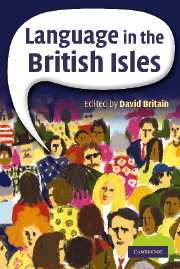Book contents
- Frontmatter
- Contents
- List of figures
- List of tables
- List of contributors
- Acknowledgements
- Map of the British Isles
- Introduction
- Part I English
- 1 The history of English
- 2 Standard and non-standard English
- 3 Phonological variation in England
- 4 Grammatical variation in England
- 5 Scottish English and Scots
- 6 Northern Irish English
- 7 Southern Irish English
- 8 English in Wales
- 9 English on the Isle of Man
- 10 English in the Channel Islands
- Part II The Celtic Languages
- Part III The Other Languages of the British Isles
- Part IV Applied Sociolinguistic Issues
- References
- Index
10 - English in the Channel Islands
Published online by Cambridge University Press: 16 January 2010
- Frontmatter
- Contents
- List of figures
- List of tables
- List of contributors
- Acknowledgements
- Map of the British Isles
- Introduction
- Part I English
- 1 The history of English
- 2 Standard and non-standard English
- 3 Phonological variation in England
- 4 Grammatical variation in England
- 5 Scottish English and Scots
- 6 Northern Irish English
- 7 Southern Irish English
- 8 English in Wales
- 9 English on the Isle of Man
- 10 English in the Channel Islands
- Part II The Celtic Languages
- Part III The Other Languages of the British Isles
- Part IV Applied Sociolinguistic Issues
- References
- Index
Summary
In traditional dialectology the Channel Islands (Jersey, Guernsey, Alderney and Sark) are regarded as a French-speaking area, because the original language in the islands is a form of Norman French that has been spoken there for centuries. Yet there can be no doubt that English is the dominant language in the islands today. The number of speakers of Norman French is relatively small and constantly decreasing. Over the last 200 years, English has gained more and more influence and has gradually replaced the local Norman French dialects. Indeed, there are clear indications that they will become extinct within the foreseeable future.
A brief look at a map (see p. 359, this volume) shows that from a geographical point of view, the Channel Islands are much closer to France than to England. Alderney is just 9 miles away from Cap de la Hague in France, while Jersey is only about 15 miles from the French coast but 90 miles south of England. Therefore, it comes as no real surprise that the native language in the Channel Islands is Norman French rather than English. From a political point of view, however, the islands have been connected with England for a long time. Originally, the islands were part of the Duchy of Normandy, but after the Battle of Hastings in 1066, Duke William II of Normandy (William the Conqueror) also became King of England, and the Duchy of Normandy was united with England under one ruler.
- Type
- Chapter
- Information
- Language in the British Isles , pp. 176 - 182Publisher: Cambridge University PressPrint publication year: 2007
- 5
- Cited by

